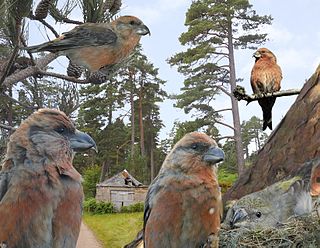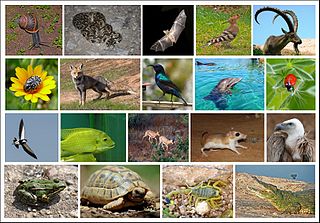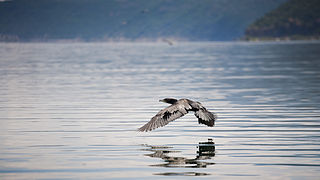Related Research Articles

The Scottish crossbill is a small passerine bird in the finch family Fringillidae. It is endemic to the Caledonian Forests of Scotland, and is the only terrestrial vertebrate species endemic to the United Kingdom. The Scottish crossbill was confirmed as a unique species in August 2006, on the basis of having a distinctive bird song.
This page features lists of species and organisms that have become extinct. The reasons for extinction range from natural occurrences, such as shifts in the Earth's ecosystem or natural disasters, to human influences on nature by the overuse of natural resources, hunting and destruction of natural habitats.

The conservation status of a group of organisms indicates whether the group still exists and how likely the group is to become extinct in the near future. Many factors are taken into account when assessing conservation status: not simply the number of individuals remaining, but the overall increase or decrease in the population over time, breeding success rates, and known threats. Various systems of conservation status exist and are in use at international, multi-country, national and local levels as well as for consumer use.

The eastern massasauga is a rattlesnake species found in central and eastern North America from southern Ontario in Canada and throughout the Midwestern and Eastern United States. Like all rattlesnakes, it is a pit viper and is venomous.
On 29 January 2010, the IUCN Red List of Threatened Species identified 5220 endangered species, subspecies and varieties, stocks and sub-populations.
Version 2014.2 of the IUCN Red List of Threatened Species identified 4574 Critically Endangered species, subspecies and varieties, stocks and subpopulations.
On 30 January 2010, the IUCN Red List of Threatened Species identified 9694 Vulnerable species, subspecies and varieties, stocks and sub-populations.

A near-threatened species is a species which has been categorized as "Near Threatened" (NT) by the International Union for Conservation of Nature as that may be vulnerable to endangerment in the near future, but it does not currently qualify for the threatened status.

A data deficient (DD) species is one which has been categorized by the International Union for Conservation of Nature (IUCN) as offering insufficient information for a proper assessment of conservation status to be made. This does not necessarily indicate that the species has not been extensively studied; but it does indicate that little or no information is available on the abundance and distribution of the species.
Threatened arthropods are defined here as any of a number of species within the phylum Arthropoda, whose extinction is likely in the foreseeable future. Estimating the number of threatened arthropod species is extremely difficult, primarily because a vast number of the species themselves are not yet named or described. Furthermore, according to Deyrup and Eisner, "The rate of destruction and degradation of natural habitats is currently so great that there are not nearly enough biologists to even catalog the arthropod species that are suddenly on the edge of extinction." In any case, independent estimates indicate that there are millions of undocumented arthropods on Earth.

The wildlife of Israel includes the flora and fauna of Israel, which is extremely diverse due to the country's location between the temperate and the tropical zones, bordering the Mediterranean Sea in the west and the desert in the east. Species such as the Syrian brown bear and the Arabian ostrich have become extinct in Israel because of their loss of habitat. As of May 2007, 190 nature reserves have been established in Israel.

Pakistan's native fauna reflect its varied climatic zones. The northern Pakistan, which includes Khyber Pakhtunkhwa and Gilgit Baltistan, has portions of two biodiversity hotspots, Mountains of Central Asia and Himalayas.

Worms are many different distantly related bilateral animals that typically have a long cylindrical tube-like body, no limbs, and no eyes.

An endangered species is a species that is very likely to become extinct in the near future, either worldwide or in a particular political jurisdiction. Endangered species may be at risk due to factors such as habitat loss, poaching and invasive species. The International Union for Conservation of Nature (IUCN) Red List lists the global conservation status of many species, and various other agencies assess the status of species within particular areas. Many nations have laws that protect conservation-reliant species which, for example, forbid hunting, restrict land development, or create protected areas. Some endangered species are the target of extensive conservation efforts such as captive breeding and habitat restoration.

A vulnerable species is a species which has been categorized by the International Union for Conservation of Nature as being threatened with extinction unless the circumstances that are threatening its survival and reproduction improve.
On 12 March 2010, the IUCN Red List of Threatened Species identified 3829 near threatened species, subspecies and varieties, stocks and sub-populations.
On 29 January 2010, the IUCN Red List of Threatened Species identified 6,702 data deficient species.

Endangered species as classified by the International Union for Conservation of Nature (IUCN), are species which have been categorized as very likely to become extinct in their known native ranges in the near future. On the IUCN Red List, endangered is the second-most severe conservation status for wild populations in the IUCN's schema after critically endangered. In 2012, the IUCN Red List featured 3,079 animal and 2,655 plant species as endangered worldwide. The figures for 1998 were 1,102 and 1,197 respectively.

Over 22,500 species of wildlife have been recorded in North Macedonia. Over 10,000 of these are insects, which include 3,000 beetle species and large numbers of Lepidoptera, flies, and Hymenoptera. Aside from insects, other large arthropod groups include Chelicerata and crustaceans. Among vertebrates, more than 300 species of birds recorded, although not all nest in the country. There are over 80 species of both fish and mammals, 32 reptiles, and 14 amphibians.

The JapaneseRed List is the Japanese domestic counterpart to the IUCN Red List of Threatened Species. The national Red List is compiled and maintained by the Ministry of the Environment, alongside a separate Red List for marine organisms. Similarly drawing on the relevant scientific authorities, NGOs, and local governments, the Ministry of the Environment also prepares and publishes a Red Data Book that provides further information on species and habitats.
References
- ↑ "IUCN Red List version 2016.1". The IUCN Red List of Threatened Species. International Union for Conservation of Nature and Natural Resources (IUCN). Retrieved 4 July 2016.
